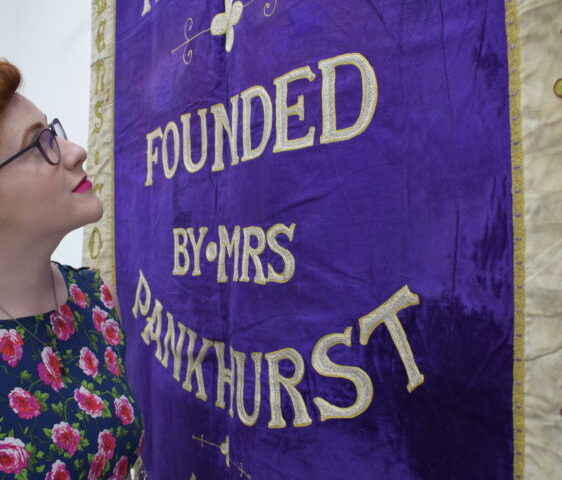The Reform Diet: Suffrage and Vegetarianism
The atrocities suffered by the imprisoned suffragettes when incarcerated have been retold many times, particularly back in 2019, the centenary year, marking 100 years since some women won the vote.

The suffragettes – militant, as opposed to the law-abiding and constitutional suffragists – were often arrested after demonstrations such as window smashing and assaults on politicians. The arrests of Charlotte Marsh and Mary Leigh in 1909 are significant here, after they threw roof tiles at the Prime Minister’s car at a political meeting in Birmingham.

As was usual for suffrage prisoners, they went on hunger strike to demand treatment as political prisoners. However, rather than being released due to ill health, they became the first women to be force fed in prison, with methods so brutal that many of the women and men who suffered this fate were left with lasting, often fatal illnesses.
Although this was the first time suffrage campaigners had been force fed, the hunger striking prisoners had been frequently reported in the local newspapers. The Women’s Social and Political Union (WSPU), looking for a way to welcome their prisoners home after months in prison, began to host Welcome Breakfasts for the released prisoners from Holloway Gaol at a vegetarian restaurant on Charing Cross Road: the Eustace Miles restaurant, owned by the health enthusiast and tennis player. Here, the WSPU would be such frequent visitors that their presence was noted by the Vegetarian Society, who stated in their journal in 1907: “Quite a number of the leaders in the Women’s Suffragist movement are vegetarians…The suffragists now invariably breakfast at the Eustace Miles restaurant, on being released from Holloway.”
The link between suffrage and vegetarianism has been repeatedly written about by suffrage historians such as Lena Leheman, as the two causes continually crossed over. As the note in the Vegetarian Society demonstrates, this is not a connection made reflectively, but something recognised, and often celebrated, by the women and the men fighting and campaigning for women’s enfranchisement in the 20th century.
It was not a surprise to find a suffragette frequenting a vegetarian restaurant. Particularly amongst the ranks of the militant WSPU, vegetarianism was a popular occurrence. From upper class, ‘celebrity’ suffragists to the working class foot soldiers of the movement, vegetarianism was being adapted as a special diet. Even during the force feeding in prison, these diets were taken into consideration. Many of the prisoners who adopted a vegetarian diet were granted special, if not basic meat-free meals in gaol. This consideration did not stretch to force-feeding. When the aristocratic Lady Constance Lytton was arrested, disguised as the working class seamstress Jane Warton, she requested for there to be a change in the food that she was fed, painfully through a tube, from a mixture of beef tea. Her biographer, Dr Lyndsey Jenkins, notes how Constance was refused – and subsequently vomited after every attempt at force feeding.
Vegetarianism was important to the women campaigning for the vote, so important that they remained as defiant about their diet as they did their political beliefs when they were in jail. But why? How did these two causes fit hand in hand?
There had been a long standing association with vegetarianism and social and political enlightenment.Particularly amongst socialists and radical thinkers, vegetarianism – already an established social movement – was especially attractive. The ethos of vegetarianism was a symbol of peace, defying the mistreatment of fellow living creatures. It’s unsurprising that many of the suffragists, who fought so tirelessly against being treated as secondary, identified with this cause. As vegetarianism was often adopted by those, such as playwright George Bernard Shaw, who supported the political freedoms of women, hosting suffrage events and dinners at vegetarian restaurants such as Eustace Miles. These events offered the women’s suffrage organisations a sanctuary, where they could openly discuss and celebrate their actions, both militant and constitutional. Indeed, these vegetarian restaurants would become so significant to the women’s suffrage campaigners that the Women’s Freedom League (WFL) would go on to open vegetarian restaurants, raising funds for the cause.
Vegetarianism steadily became more and more popular amongst the suffrage campaigners. The younger members, in particular, were inspired by the older leaders of the movement, such as Anne Cobden-Sanderson. Cobden-Sanderson was the daughter of Richard Cobden, a radical reformist who had been instrumental in the repealing of the Corn Laws. Cobden-Sanderson – who was part of the infamous Black Friday in November 1910, where a deputation of suffragists and suffragettes were viciously attacked and assaulted by police as they approached parliament – was a prolific member of the National Food Reform Association, founded in Grosvenor Square, London. In the same year Anne attended the founding meeting of the Association, she published How I Became A Vegetarian, printed by Dove’s Press, founded by her husband.
The vegetarian movement spanned classes. Whilst women such as Lady Constance Lytton and Anne Cobden- Sanderson were from wealthy and, in the case of Constance Lytton, aristocratic backgrounds, working-class suffragettes also adopted the diet. Leonara Cohen, who had been raised by her widowed mother, a seamstress, had worked as a milliner’s apprentice. Leonora had suffered TB as a child, and subsequently the family had adopted a vegetarian diet, believing, like Constance Lytton, in its health benefits. Publications at the time made vegetarianism attractive to the working mother, stressing the lack of expense – and saving of housework – the diet offered. The political ties would often follow. Indeed, when Leonora, later in life, opened a boarding house in Harrogate, she advertises it in the Suffragette as ‘…catering by specialist in Reform diets.’ It’s telling that she advertises this particular element, especially her stress of the specialist catering – knowing it would appeal not just to a few singular women, but the many campaigners whose fight for suffrage had led them, also, to lead a guilt-free, humanitarian diet.
Twenty years ago, my father wrote a book about the beginnings of the Vegetarian movement, at William Cowherd’s church in Salford. His regret in the book was not uncovering more about the church’s connection to the women’s movement. It’s fitting, however, that, only a few miles down the road, almost sixty years after Cowherd’s proclamation to his congregation that no meat should be eaten, another great, radical movement would begin in Manchester and Salford. The fight for women’s suffrage would continue to fly the flag for vegetarianism, and the fight for a better, fairer, and kinder world.
Helen Antrobus is the Programme Officer at the People’s History Museum. As a researcher and historian, she has appeared on several programmes for the BBC, including Who Do You Think You Are, The One Show, Britain’s Lost Masterpieces, Great Lives and Ramblings. In 2019, the People’s History Museum hosted an exhibition called Represent! Voices 100 Years On, which told the story of representation then and now, from the suffragists to campaigners today. Header photo credit: Helen Antrobus with the Manchester suffragette banner, 1908 © People’s History Museum.
